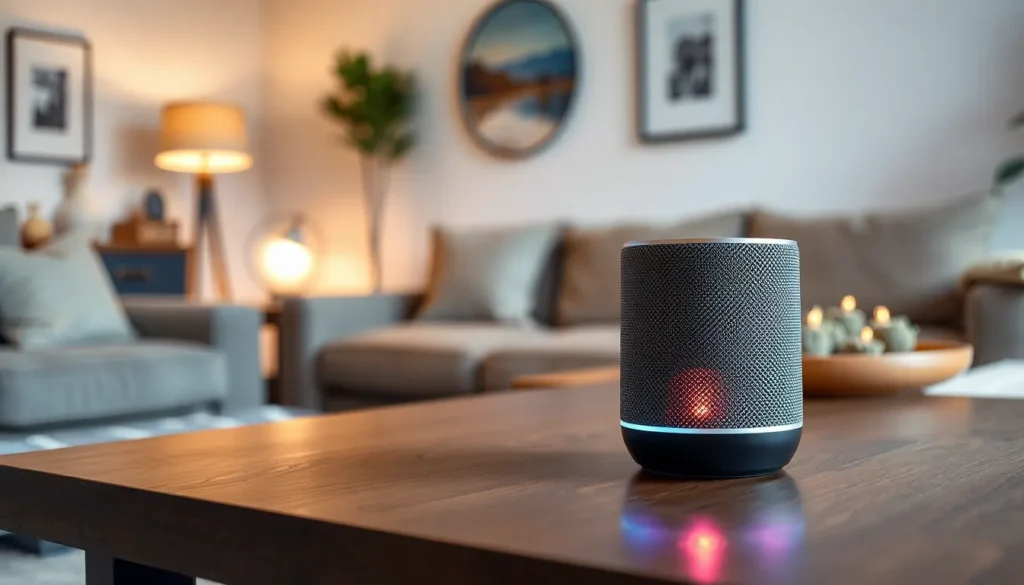Table of Contents
ToggleIn a world where talking to your devices feels like a scene from a sci-fi movie, voice trigger responses are the unsung heroes of modern technology. Imagine asking your smart speaker to play your favorite song, and it instantly knows what you want—no awkward fumbling or typing required. It’s like having a personal assistant who never judges your late-night playlist choices.
Overview of Voice Trigger Responses
Voice trigger responses represent a key development in user interaction with technology. These responses create an intuitive and efficient way for users to engage with devices.
Definition and Importance
Voice trigger responses encompass automated actions initiated by specific verbal prompts. This technology interprets voice commands, enabling hands-free operation. Importance lies in increasing accessibility for users, allowing interaction without physical input. Time savings occur as users access information, services, or control devices quickly. This convenience enhances daily life, positioning technology as a seamless extension of users’ needs.
Applications in Technology
Applications for voice trigger responses span various fields. Smart home devices respond to commands for lighting, temperature, and security adjustments. Mobile assistants aid users in setting reminders and answering queries. Automotive systems enable hands-free navigation and communication while driving. Moreover, businesses utilize this technology for customer service, improving response times and satisfaction. These applications demonstrate the versatility of voice trigger responses in enhancing user experience across numerous platforms.
How Voice Trigger Responses Work

Voice trigger responses rely on advanced technologies to interpret and execute commands. These automated actions transform user interactions with devices.
Speech Recognition Technology
Speech recognition technology serves as the backbone of voice trigger responses. This technology allows devices to convert spoken language into text. By training on vast datasets of audio samples, it learns to recognize diverse accents and pronunciations. Real-time processing ensures quick response times. Smart speakers and virtual assistants utilize sophisticated algorithms to improve accuracy over time. Users can initiate actions, such as setting reminders or controlling smart home devices, solely through verbal commands.
Natural Language Processing
Natural language processing enhances the understanding of human speech. Through NLP, devices interpret context and intent behind words. Algorithms analyze syntax and semantics to decipher complex phrases. By doing so, systems can respond appropriately, even to nuanced questions. NLP capabilities allow for engaging conversations, making interactions feel more lifelike. Companies leverage these techniques to continually refine user experiences across various platforms. These technologies ensure that voice trigger responses feel intuitive and efficient.
Benefits of Voice Trigger Responses
Voice trigger responses significantly enhance user interactions with technology. They streamline tasks and create seamless communication between users and devices.
Increased Efficiency
Voice trigger responses save time by allowing users to execute tasks instantly. Users can start playlists, set timers, or request information without manual input. Automating common commands through voice eliminates the need for physical interaction, which increases overall efficiency. Devices respond quickly to verbal prompts, minimizing delays that typically occur with traditional inputs. Additionally, users can accomplish multiple tasks simultaneously using simple voice commands. This optimization leads to a more productive environment.
Enhanced User Experience
Voice trigger responses improve accessibility for diverse users. People with mobility impairments find it easier to control devices through voice rather than physical actions. Engaging with technology feels more intuitive when users can speak commands naturally. Each interaction becomes more personal and satisfying, creating a sense of connection with devices. Accurate recognition of voice commands reduces frustration, enhancing overall satisfaction. Simplicity in operation encourages wider adoption across various demographics, positively impacting user experiences with technology.
Challenges and Limitations
Voice trigger responses face several challenges that can affect user experience and wider adoption. These obstacles include accuracy issues and privacy concerns.
Accuracy Issues
Accuracy issues remain a significant challenge for voice trigger responses. Sometimes, speech recognition may misinterpret commands, especially with diverse accents or in noisy environments. This misinterpretation can lead to frustration when a device does not execute the intended action. Users may find themselves repeating commands unnecessarily, which diminishes the technology’s convenience. Additionally, background noise can hamper performance, causing delays and incorrect responses. Continuous improvement of algorithms is crucial to enhance recognition accuracy and user satisfaction in various contexts.
Privacy Concerns
Privacy concerns play a critical role in the adoption of voice trigger responses. Many users worry about the collection and storage of voice data by smart devices. Instances of unauthorized access to personal information heighten these concerns. Individuals often fear that their conversations are being monitored, leading to hesitance in using such technology. Ensuring robust security measures and transparent data practices can help alleviate these fears. Users seek assurance that their voice commands are protected and that their privacy is respected in all interactions with smart devices.
Future Trends in Voice Trigger Responses
Voice trigger responses are poised for significant evolution, driven by advancements in technology and user demand for seamless interaction.
Advances in Artificial Intelligence
Artificial intelligence is set to enhance the accuracy and responsiveness of voice trigger systems. AI improves voice recognition by utilizing machine learning algorithms to analyze user patterns and preferences. These systems learn from interactions, refining their ability to understand diverse accents and dialects. Enhanced natural language processing allows voice triggers to interpret context more effectively. As AI continues to advance, conversations with devices will feel more natural and intuitive. Advanced models will also support emotional recognition, enabling more personalized responses to user queries.
Integration with Smart Devices
Integration with smart devices continues to expand, creating an interconnected ecosystem that enhances user experience. Voice trigger responses operate alongside various devices, from lights to thermostats, amplifying convenience. Compatibility with an increasing number of smart home products promotes easier management of daily tasks. Users can control multiple devices with simple voice commands, streamlining routines. Moreover, this integration empowers new applications, allowing for automated scenarios based on user preferences. As more devices adopt voice trigger technology, the way users interact with their environments will become increasingly effortless and intuitive.
Voice trigger responses are revolutionizing the way users interact with technology. By enabling hands-free commands and seamless communication, they not only enhance convenience but also improve accessibility for individuals with mobility challenges. As advancements in AI and machine learning continue to refine these systems, users can expect even greater accuracy and responsiveness in their interactions.
Addressing challenges like accuracy and privacy will be crucial for wider adoption. With ongoing improvements, voice trigger technology is poised to become an integral part of daily life, transforming how individuals engage with their devices. The future looks promising as this technology evolves, making interactions more intuitive and efficient.







